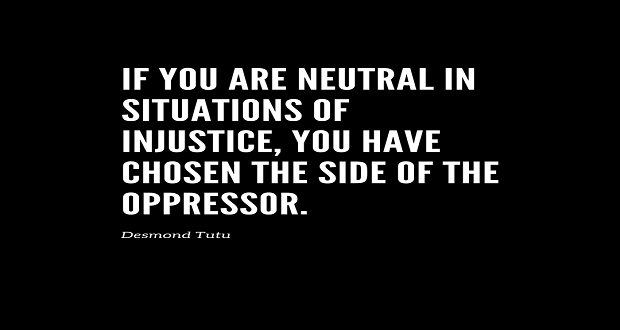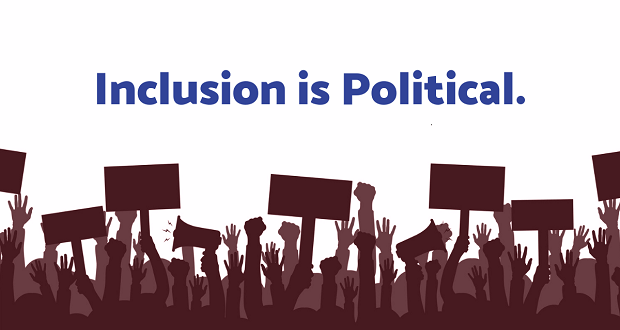
“We must take sides. Neutrality helps the oppressor, never the victim. Silence encourages the tormentor, never the tormented” – Elie Wiesel
“Washing one’s hands of the conflict between the powerful and the powerless means to side with the powerful, not to be neutral.” – Paulo Freire
“The hottest place in Hell is reserved for those who remain neutral in times of great moral conflict…[an individual] who accepts evil without protesting against it is really cooperating with it” – Martin Luther King Jr.
#Message.
Each of these quotes capture the urgency in “choosing” a side. These leaders speak of the danger in maintaining neutrality, particularly during turbulent, polarizing times—times like the ones we’re experiencing today. Whether it’s legislative actions that threaten the safety of those who call this country home, rhetoric that blatantly incites hate and prejudice, or sentiments that suggest symbols [and flags] matter more than Black lives, our current climate clearly threatens our strides toward equity and inclusion.
That said, how should organizational leaders and diversity & inclusion practitioners be responding? When is it appropriate for organizations and leaders to take a stand? Should inclusion be political? Do all perspectives and opinions matter? Where do we draw the line?
Let’s Talk About It …
If this era teaches us nothing else about diversity and inclusion work, when it’s all said and done, I believe we’ll have a clearer understanding of the organizations and leaders who are truly committed to this work. For years, it has been fairly ‘easy’ for organizations to espouse their commitment to diversity and inclusion by way of beautifully crafted diversity mission and vision statements, well-intentioned leadership inclusion councils, and generous corporate philanthropy efforts. Certainly, these efforts are necessary and remain critical components of a broader diversity and inclusion strategy, but in times like these, is it really enough?
I don’t believe it is. In a climate where it seems as though the voices of hope, change, and inclusion have become muffled by a “noise” that perpetuates regression, polarization, and bigotry, organizations and leaders must be bolder. If a culture of inclusion and equity is the goal, then positions of neutrality will be insufficient, and risk will be inevitable. Speaking up, “choosing a side,” and standing for all naturally require that some perspectives or opinions will be prioritized over others. This can feel like a threat for those organizations who historically have wanted all perspectives to matter.
For example, we’ve had clients share their concerns around employees who support President Trump feeling excluded if they take a stand. We’ve seen organizations and leaders undermine ERGs and affinity groups to prioritize the inclusion of white men. We’ve heard leaders and even fellow D&I practitioners continue to skirt around ‘race’ as a dimension of difference and ‘racism’ as a broader issue requiring urgent attention. Ironically, we’ve even seen organizations whose whole purpose is to foster inclusion and equity intentionally avoid using phrases like ‘anti-Trump,’ to avoid disenfranchising Trump supporters and making inclusion political.
This what neutrality sounds like. While well-intended, these sentiments do not support inclusion; they don’t push for equity; they will not challenge [what has become] our status quo. We really have to draw the line.
When neutrality is at odds with inclusion, consider the following:
- Words matter. What those words mean to your organization matter even more. What does inclusion mean at your organization, and what do those behaviors look like? Identifying common language is requisite to taking a stand. If your organization stands for, equity, then you should proactively be affirming that in your communications, partnerships, policies, and positions on current events.
- Taking a stand means taking a risk. The reality is, every employee and customer will not agree with that stance. However, espousing diversity, inclusion, and equity requires accountability. Which means prioritizing living out these ideals over playing it safe just to accommodate those perspectives that are in contrast with them. Sometimes being inclusive means excluding problematic and harmful perspectives and opinions.
- Be Bold, and have the tough conversations. Now is not the time to retreat to our safe spaces for dialogue around generations and gender—topics that we’ve often used to avoid having the difficult conversation around topics like race. If there were ever a time to challenge yourself and others to lean into one’s discomfort, the time is now. Race is real, racism is real, the discomfort and shame often experienced when talking about both is real. But that’s okay. We certainly cannot address these issues if we’re still avoiding talking about them. Mary-Frances Winters offers guidance on how to begin to create these spaces in her newest book, We Can’t Talk About That at Work! How to Talk About Race, Religion, Politics and Other Polarizing Topics.
- Inclusion is Political. This is probably debatable. But today, I contend that inclusion is political. When we have a president whose policies and rhetoric not only challenge traditional political discourse and procedure but threaten people’s lives and psychological safety, affirming inclusion requires action beyond the walls of the organizations. Organizations and leaders play a critical role in influencing policy and legislation. Leaders who stand for inclusion and equity must be willing to leverage their power and influence to affect change. The work around inclusion doesn’t end at the corner office door.
When do we draw the line? Now.



















Wonderful and insightful article! Thanks for your genuinely inclusive perspective on such an important social issue.